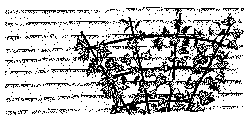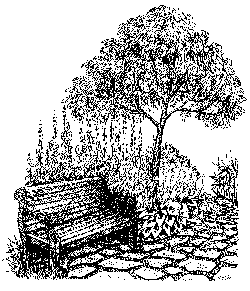Well-placed plantings can significantly temper the microclimate around a
home, resulting in a more comfortable environment and big savings in heating and
cooling costs over time.
Return to Table of Contents
In a windy site, a windbreak or shelterbelt planting can account for up to 50
percent wind reduction with a 20 to 40 percent reduction in heating fuel
consumption. In a calmer spot, wind barriers can still reduce fuel use by 10
percent or more.
A wind barrier that permits 50 to 60 percent wind penetration is more
effective than a solid barrier because it provides a larger area of protection
on the leeward side. Evergreen conifers (needle-leaf trees) are a perfect
barrier to winter winds.

Location. The correct location of a windbreak is essential to its
ability to cut fuel consumption. Windbreaks should be placed at right angles to
the prevailing winter wind-on the north and west in most parts of Virginia. The
windbreak should be longer than the area to be protected. Wherever space
permits, an extension on the east side will help, too. Generally, savings from
windbreaks increase as the protected perimeter of a house increases; however,
even only a few well-placed trees make a difference.
Wind reduction downwind occurs for a distance up to 30 times the height of a
windbreak; the amount of reduction varies depending on the density (the
thickness of branches and foliage) of the windbreak. Therefore, a house receives
the most protection from a 20-foot-high planting not more than 400 feet from the
windward side. If a windbreak is required on the south side, it must be placed
farther away to prevent winter shading.
Suitable Species. Choose a relatively fast- growing, dense conifer
species with stiff branches that will mature at a height about 1 1/2 times the
height of the house. The species should retain branches low to the ground at
maturity.
White pine drops its lower branches and is not recommended as a primary
windbreak. If you have or wish to use a white pine windbreak on your property,
add a row of dense evergreen shrubs, such as arborvitae, to the windward side.
Norway, white, and Colorado blue spruce are among the best windbreak trees;
blue spruce usually provides the most protection, but is slower-growing than the
others. Check locally to find evergreens that grow best in your area.
Spacing. The effectiveness of a windbreak generally increases with
each added row, up to five rows. With dense trees such as spruce, two rows are
usually the most cost-effective. The spacing of trees within a windbreak depends
on the species used. Pine and spruce should be placed about 6 feet apart in the
rows. Cedar and arborvitae should be 3 to 4 feet apart. The rows should be
roughly 10 to 12 feet apart, and should be staggered, not aligned.
Preparation and Planning. Soil preparation prior to planting should
include testing the soil and applying nutrients and lime as recommended, in
addition to breaking compacted soil to a depth of 6 to 15 inches. Early spring
is a good time to plant windbreaks, as it allows the plants to acclimate to the
site before the first winter.
Return to Table of Contents
Well-placed trees and shrubs can also help cut air conditioning costs. Trees,
shrubs, ground covers, and grass affect solar radiation more than structural
devices, such as awnings. Deciduous plants drop their leaves in winter and have
the advantage of allowing sun to reach buildings in the winter for warmth, yet
providing shade during the summer. Shade trees can significantly reduce air
temperatures indoors in the summer, as trees intercept and soak up the sun's
heat while transpiring cooling moisture into the air. Air- conditioners run much
less in a house shaded by trees than they do in a house with a sunbaked roof and
walls. Shade trees should be planted mainly to the south and west sides of the
house. The placement of shrubs around an outdoor condenser or heat pump also
saves energy.
The major considerations for selecting shade tree species for summer cooling
are adaptability to your site, ease of maintenance, and aesthetics. Most
broad-leaved, deciduous trees are dense enough to block direct summer sun rays.
Shrubs can also help reduce energy use by shading walls in summer, but don't
allow tall- growing shrubs to block the winter sun from your windows. In summer,
deciduous vines on trellises can be used to cool walls which face south or west.
Behind the trellis, a convection current carries warm air away from the wall.
Added summer heat reduction can come from the use of lawn grasses and ground
cover plants. Glare can be reduced by lawns, and green ground covers outside of
windows also reduce summer temperatures of the immediate area by 10 to 14
percent.
Return to Table of Contents
In placing shade trees and windbreaks, consider their year-round effect.
Deciduous trees will not block the winter sun as much as conifers will. But even
deciduous trees can reduce solar radiation by about 20 to 50 percent in winter
(depending on species and size), since even bare branches block the sun's rays.
Proper location of shade trees will shade the most important parts of the house
in the summer without shading too much in the winter.
In general trees on the east or west sides of the house provide summer shade
without excessive winter shade. In cold areas, leave the south clear so the sun
is not blocked during the winter, unless you use a species with compound leaves,
such as ash or honey locust, which usually have a less dense branch structure.
Ash trees are a good choice for a south-facing planting in cold areas, as they
are among the last trees to leaf out in spring and the first to drop their
foliage in autumn.
A solid row of evergreens next to a wall can create a dead air space, and
consequently, a year- round insulating effect, although mold and mildew can
sometimes occur. The evergreens can be trees, shrubs, or vines. Evergreen vines
like English ivy can be used on a trellis on a north- facing wall to insulate
and inhibit winter winds.
Return to Table of Contents
Planting for energy savings combines well with other commonly recognized
landscaping benefits. A windbreak provides privacy and noise deflection, in
addition to wind and snow diversion. Shade trees beautify the yard and provide a
habitat for local wildlife, as well as protecting you and your home from sun and
wind. Healthy, well-maintained trees and shrubs increase the value of your
property overall.
Reducing lawn areas can also save energy-by planting ground covers or
understory shrubs, less mowing is required. Plus, if drought-tolerant plants are
used, water use can be significantly reduced.
Return to Table of Contents
![]() Gardeners' Corner
Kids'
Garden
Sustainable Garden
Contact Us
Gardeners' Corner
Kids'
Garden
Sustainable Garden
Contact Us![]()





